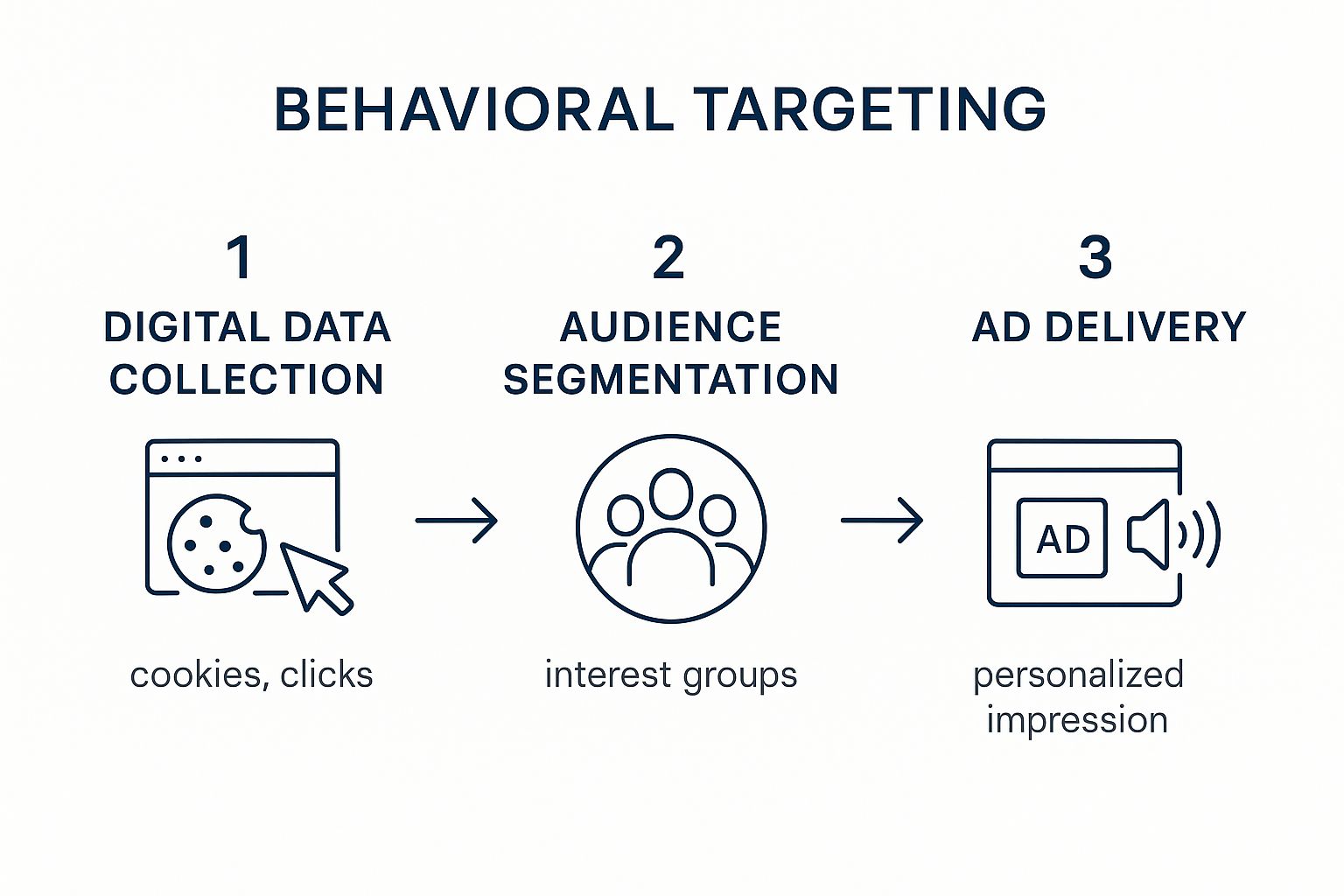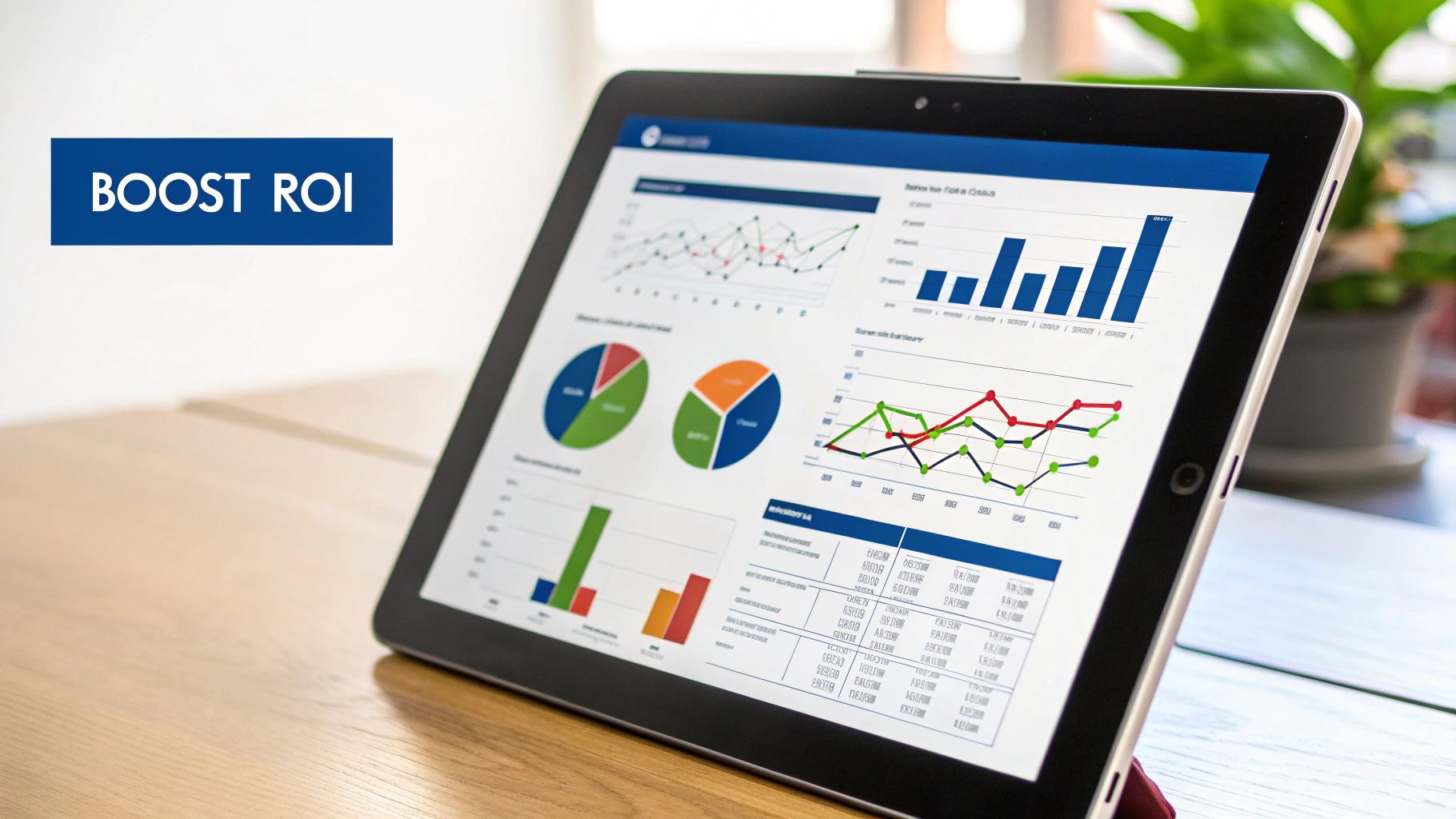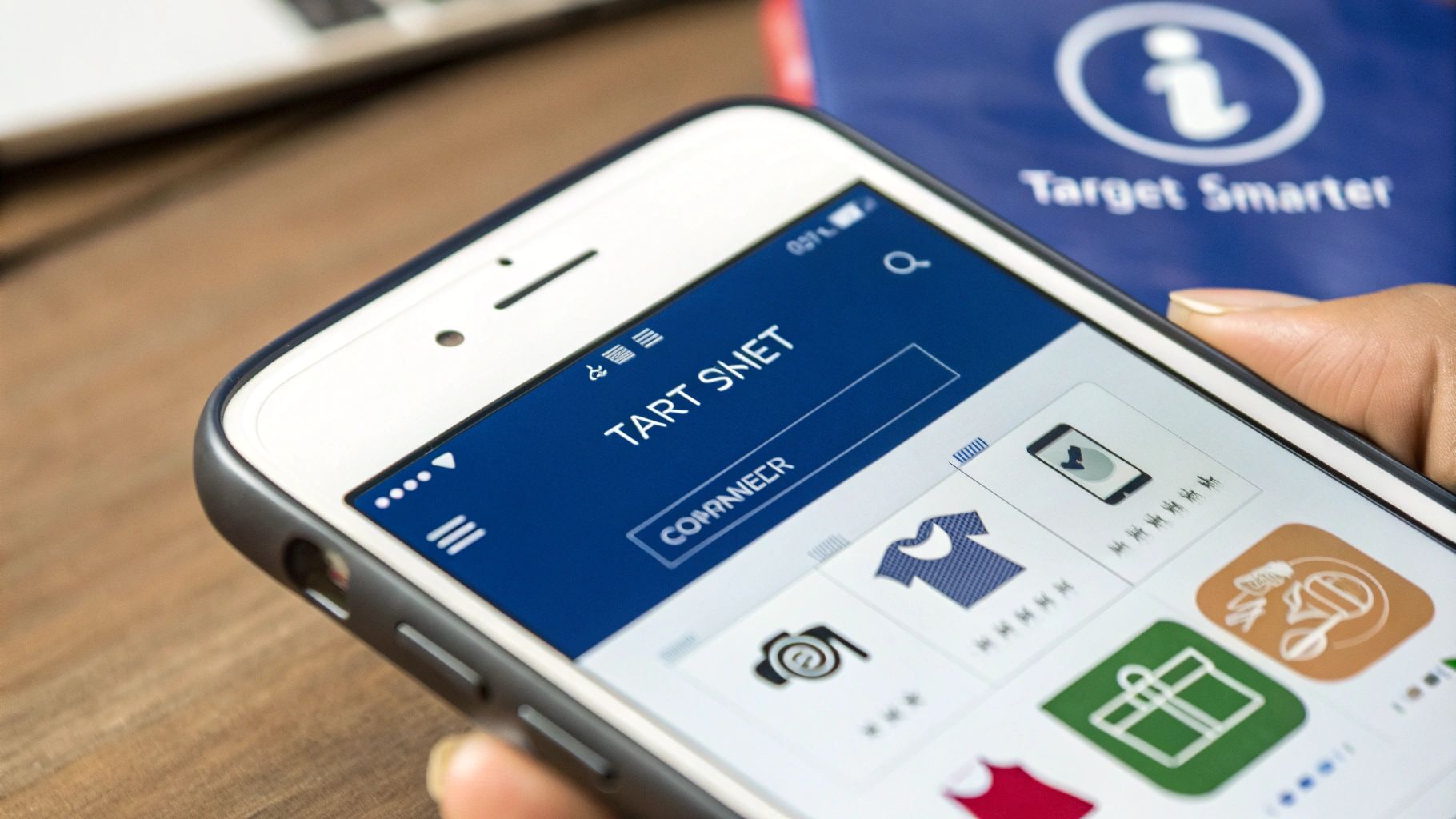What Is Behavioral Targeting? A Performance-First Guide for Amazon Brands
Learn what is behavioral targeting and how Amazon brands can use it to drive PPC performance, profitability, and organic growth. Start building your strategy.

Behavioral targeting uses a customer's digital footprint—their searches, clicks, and purchase history—to serve ads that are hyper-relevant to their immediate intent.
For eCommerce leaders, it's the strategic difference between shouting into a crowded room and having a one-on-one conversation about a product you know the customer is considering. On Amazon, this isn't just another marketing tactic; it's a core lever for turning ad spend into profitable, sustainable growth and a stronger organic presence.
Understanding Behavioral Targeting in Ecommerce
Imagine having a digital personal shopper for every potential customer. Instead of relying on broad demographic assumptions, you observe their "digital body language" to understand their true intent.
This means tracking high-intent signals like specific product page visits, cart additions, past purchases, and even dwell time on certain features. The objective is to eliminate generic, one-size-fits-all ads and deliver messages that convert because they’re based on demonstrated interest.
This approach lets you move past broad, often inaccurate demographic guesses. Instead, you're connecting with shoppers based on what they are actually doing. A core idea here is understanding what behavioral segmentation is, which is just a way of grouping customers into different buckets based on these actions.
This simple infographic shows you exactly how that online behavior gets turned into a personalized ad.

This flow shows the whole journey, from an anonymous click to a super-relevant ad, which is really the backbone of any advertising strategy that’s focused on performance.
To see just how different this approach is, let's compare it side-by-side with more traditional methods.
Behavioral Targeting at a Glance
| Attribute | Traditional Advertising | Behavioral Targeting |
|---|---|---|
| Audience | Broad, demographic-based (e.g., age, gender) | Specific, action-based (e.g., viewed product X) |
| Messaging | Generic, one-to-many | Personalized, one-to-one |
| Timing | Scheduled, often misses the moment of intent | Real-time, based on current user activity |
| Efficiency | Lower ROI, high ad waste | Higher ROI, minimal wasted spend |
| Goal | Brand awareness, broad reach | Conversions, direct sales, profitability |
This table makes it clear: behavioral targeting is all about precision and efficiency, meeting customers exactly where they are in their buying journey.
The Impact on Your Bottom Line
The performance uplift from this kind of targeting is significant. According to McKinsey, personalization—powered by behavioral data—can lift revenues by 5 to 15% and increase marketing spend efficiency by 10 to 30%. For Amazon brands, this means every ad dollar works harder.
This level of precision is exactly why the global behavioral analytics market is expected to rocket to nearly $10.8 billion by 2032. These numbers aren't just trivia; they point to a huge shift in advertising. Relevance drives revenue, making this an essential strategy for any brand serious about profitable scale on Amazon.
How Behavioral Targeting Actually Works
Think of behavioral targeting as a savvy digital detective. It doesn't guess what shoppers might want; it observes their actions, notes their habits, and then presents them with offers they're likely to be interested in—sometimes before they even realize it themselves. It's not magic, just a methodical, data-driven system that works in three clear stages.

The whole point is to turn anonymous clicks into valuable, highly relevant ad placements. It’s about connecting your brand with shoppers at the exact moment they’re most likely to buy, making your ads helpful rather than intrusive.
Stage 1: Data Collection
Everything starts with collecting the digital "breadcrumbs" people leave behind as they move around the internet. This isn't about gathering personal identities, but about picking up on anonymous signals that hint at what someone is interested in.
This data comes from a few key places:
- Tracking Pixels and Cookies: These are tiny snippets of code on a website or in an ad. They keep track of what users do, like which pages they look at, what they put in their shopping cart, or how long they linger on a product.
- CRM and First-Party Data: This is information you already have on your customers. Think purchase histories or how they've interacted with your email newsletters.
- On-Platform Behavior: On a site like Amazon, this is gold. It includes what people search for, which Sponsored Product ads they click, and how much time they spend on a product detail page.
All these little pieces of information are gathered up to build a rich, anonymous profile of a user's interests and habits.
Stage 2: Audience Segmentation
Once you have all that data, the next job is to sort these anonymous users into logical groups, or audience segments. This is the step where raw data starts to look like a real strategy. Instead of a messy pile of a million individual data points, you begin to see distinct customer profiles emerge.
The goal of segmentation is to group users based on shared behaviors and demonstrated intent, allowing you to move from one-size-fits-all advertising to a truly personalized approach.
On Amazon, for instance, you could create segments like:
- "In-Market for Running Shoes": People who have recently browsed several pairs of running shoes.
- "Brand-Aware Shoppers": Anyone who has visited your brand’s storefront or specifically searched for your brand name.
- "Cart Abandoners": Shoppers who added one of your products to their cart but didn't finish the checkout process.
Stage 3: Ad Delivery and Retargeting
This is the final step, where you deliver the right ad to the right group. If someone falls into your "Cart Abandoners" segment, you can hit them with a Sponsored Display ad showing them the exact product they left behind. This is a classic, powerful form of behavioral targeting. To get a better handle on this tactic, you can learn more about what retargeting is in digital marketing in our detailed guide.
By matching a specific ad message to a specific audience segment, your ad spend suddenly becomes much more effective. You stop throwing money away on people who aren't interested and instead focus your budget on those who have already shown they're in the market for what you sell. That kind of precision is what really drives profitable growth.
The Strategic Benefits for Performance-Focused Brands
It's one thing to understand the mechanics of behavioral targeting, but it's another thing entirely to see how it directly grows your business. For brands obsessed with performance, this isn't just about clever ad placements; it's a fundamental engine for profitable, scalable growth. The benefits aren't just theory—they show up as real, measurable results that make your entire operation stronger.

When you focus your ad budget on shoppers who have already shown they’re interested, you stop pouring money down the drain on audiences who just don't care. That kind of precision is what makes sustainable scale possible, turning your PPC efforts into a direct lever for long-term organic growth and market leadership.
Drive a Higher Return on Ad Spend
The first and most obvious win from behavioral targeting is a major boost to your Return on Ad Spend (ROAS). You’re no longer casting a wide, expensive net. Instead, you're zeroing in on people who are already on their way to making a purchase.
Actionable Insight: An Amazon Sponsored Display campaign can specifically retarget shoppers who viewed your product detail page in the last 30 days but didn't convert. Showing them a gentle reminder ad is vastly more efficient than trying to win over a completely cold audience. The result? Higher conversion rates and a much healthier ROAS. This is a core tactic in many advertising strategies, which you can read more about in our guide on what is programmatic display advertising.
Increase Customer Lifetime Value
Behavioral data is golden for keeping customers, not just finding new ones. By looking at what people have bought before, you can group your loyal customers together and send them targeted offers for related products or exciting new launches.
Takeaway: Smart targeting encourages repeat business, turning one-time buyers into loyal fans. This shifts your advertising from a simple expense to a real investment in building strong customer relationships and long-term profit.
Let's say a brand sells coffee makers. They could use Amazon DSP to show ads for coffee filters or a new dark roast blend to everyone who previously bought their machine. This doesn't just drive another sale—it strengthens the customer's connection to the brand, ultimately boosting their Customer Lifetime Value (CLV).
Build Lasting Brand Loyalty
Finally, behavioral targeting helps you build a strong brand by making your advertising feel more relevant and way less annoying. When your ads actually seem helpful, people start to see your brand in a much more positive light.
The rapid growth in this space mirrors the expansion of the entire behavior analytics market. Valued at $1.10 billion, it's expected to surge to $10.8 billion by 2032. This incredible jump highlights just how vital it is for businesses to understand customer actions to build loyalty and stay ahead of trends. You can dive deeper into these numbers by reading the full analysis from Fortune Business Insights.
Putting Behavioral Targeting to Work in Your Amazon Strategy
It’s one thing to talk about behavioral targeting in theory, but putting it into practice on Amazon is where the magic really happens. For brands selling on the platform, this isn't just about buzzwords; it's about using specific, powerful tools to get in front of the right shoppers at the right time.
The two main ways to do this are through Sponsored Display ads and the Amazon Demand-Side Platform (DSP). Both move beyond basic keyword targeting, letting you build audiences based on what people actually do—like viewing certain products, searching for your competitors, or buying from related categories.
Choosing the Right Tools for the Job
Deciding between Sponsored Display and Amazon DSP really comes down to what you're trying to achieve.
Sponsored Display is a fantastic starting point. It's perfect for retargeting shoppers who’ve already landed on your product pages but didn't buy. Think of it as a simple, effective way to bring back lost traffic and nudge those "almost" customers over the finish line.
The Amazon DSP, on the other hand, is a much bigger and more powerful machine. It lets you create incredibly specific audience segments and reach them both on and off Amazon. If you're looking for a deep dive, our guide on DSP advertising on Amazon unpacks how it can fuel growth across your entire sales funnel.
This screenshot from Amazon Advertising really captures the DSP's power to find your audience wherever they are.

The key takeaway here? DSP campaigns aren't just limited to Amazon.com. You can follow high-intent shoppers across the web and gently guide them back to your product listings.
To help clarify which tool fits your needs, here's a quick breakdown of how Amazon's advertising options handle behavioral targeting.
Amazon Advertising Options for Behavioral Targeting
| Ad Type | Targeting Mechanism | Best Use Case |
|---|---|---|
| Sponsored Display | Product & Views Targeting | Retargeting shoppers who viewed your (or similar) products. Great for bottom-of-funnel conversion. |
| Amazon DSP | In-Market & Lifestyle Audiences | Reaching new customers based on broad shopping and browsing patterns, both on and off Amazon. |
| Amazon DSP | Competitor Conquesting | Targeting users who have recently viewed specific competitor products but haven't bought yet. |
| Amazon DSP | Re-engagement & Loyalty | Reaching past customers with new products or reminding them to re-purchase consumable items. |
This table shows that while Sponsored Display is a sharp tool for retargeting, the DSP opens up a whole world of proactive, behavior-based audience building for every stage of the customer journey.
A Real-World Example: The Running Shoe Brand
Let's make this less abstract. Imagine you sell high-performance running shoes. The old-school approach would be to bid on generic keywords like "men's running shoes" and hope for the best. A behavioral targeting strategy is far smarter.
Using the Amazon DSP, this brand could build a few killer audience segments:
- Competitor Conquesting: Target shoppers who recently looked at product pages for top rivals like Brooks or Hoka but didn't buy. This is your chance to slide in and present your shoe as a better option right when they're making a decision.
- Lifestyle Affinity: Go after people who recently bought things like fitness trackers, workout clothes, or protein powder. These purchases are strong signals that they lead an active lifestyle, making them perfect candidates for new running gear.
- Brand Re-engagement: Create an audience of customers who bought your previous shoe model 9-12 months ago. You can serve them ads for the latest upgrade, encouraging them to stick with your brand and fostering real loyalty.
This changes everything. Instead of just throwing money at ads, you're making a strategic investment. By focusing only on shoppers who have shown clear intent, the running shoe brand ensures its ad budget is working as hard as possible to grow market share and boost profits.
Navigating a Future with AI and Privacy
The playbook for behavioral targeting is being rewritten right before our eyes. Two massive forces are pulling the industry in new directions: the incredible rise of artificial intelligence and the non-negotiable demand for user privacy.
For brands that care about performance, figuring out how to balance these two isn't just a good idea—it's the only way to build an advertising strategy that lasts. This isn't about small tweaks. It’s a complete shift in how we think about and use data.
The Rise of Predictive AI
AI and machine learning are making targeting smarter and more precise than ever. These systems can sift through millions of data points in a split second, spotting tiny patterns in shopper behavior that a human analyst would almost certainly miss.
This lets you do things that were once impossible, like dynamically optimizing campaigns on the fly. AI can automatically adjust your bids, swap out creatives, and refine audience segments to get the best possible results.
AI-powered targeting platforms use this real-time data to make instant decisions on ad content and placement. More importantly, the best systems are built with privacy in mind from the ground up, anonymizing user data to address both consumer and regulatory concerns. As you can read in this 2025 AI trends report, this shift is all about creating smarter, more responsible advertising.
The Challenge of Privacy and Data Stewardship
While AI is opening new doors, the global push for privacy is closing others. We’re seeing the phase-out of third-party cookies and the enforcement of major regulations like GDPR and CCPA. The old methods of tracking people across the web are quickly becoming a thing of the past.
This is a huge challenge, no doubt. But it’s also a massive opportunity for brands that are ready to adapt.
The Takeaway: With third-party cookies disappearing, your own first-party data is now gold. The information you collect directly from your customers—things like their purchase history, email sign-ups, and how they browse your site—has become your most powerful strategic asset.
Winning in this new era comes down to building trust and giving people real value in exchange for their information. As you navigate the future of marketing, it's critical to understand evolving privacy policies and build your strategies around transparency and consent.
This new reality forces a smarter, more ethical approach. The brands that will succeed are the ones using privacy-first platforms like Amazon’s advertising ecosystem, which is built on its own treasure trove of first-party data. By focusing on the data you own and the platforms that respect users, you can create a sustainable advertising model that drives incredible performance without compromising on the ethical standards that today's shoppers expect.
Your Blueprint for Profitable Growth
Behavioral targeting is more than just a clever way to place ads. It's a roadmap for understanding your customer journey and engineering profitable growth. When you look beyond surface-level metrics like ACOS, you begin to see the bigger picture: how strategic PPC spend directly fuels organic rank, which in turn builds a more resilient and profitable business.
Every click, search, and purchase tells a story. Your job is to translate that story into a performance-driven strategy. This means shifting focus from simply selling products to solving problems for specific, high-intent audiences. It's about showing up at the right moment—whether a shopper is discovering your category for the first time or is a loyal customer ready to repurchase.
Your Next Move
The first step to unlocking this growth is putting your customer data to work. This is exactly what tools like Amazon DSP were designed for—turning behavioral insights into market share. By building precise audiences based on competitor views, complementary product purchases, or past brand engagement, you transform advertising from an expense into a strategic investment.
The Takeaway: Stop treating advertising as a silo. Start using behavioral targeting as the engine for your entire Amazon flywheel. When you understand who your customers are and what they're doing, you create a powerful cycle where efficient ads lift organic rank, drive loyalty, and build a more profitable brand for the long term.
Common Questions About Behavioral Targeting
Let's clear up some of the most common questions we hear from ecommerce leaders about behavioral targeting and how to put it to work.
Isn't This Just the Same as Contextual Targeting?
Not at all. They’re two different tools for two different jobs.
Think of it like this: contextual targeting puts your ad in a relevant place, while behavioral targeting puts your ad in front of a relevant person.
So, a contextual ad for running shoes might pop up on a blog post titled "The 5 Best Running Shoes of 2024." It’s all about the environment. A behavioral ad, on the other hand, follows a specific shopper who has been looking at running shoes online, showing them that ad even when they’re reading the morning news. It’s all about the individual's past actions.
What Happens to Behavioral Targeting When Third-Party Cookies Go Away?
This is a big deal, for sure. The slow death of the third-party cookie changes the game, but it doesn't end it. It simply makes the data you collect yourself—your first-party data—incredibly valuable. The strategy is shifting away from tracking people all over the web and toward understanding the customers you already interact with.
This is where Amazon has a huge leg up. Amazon's entire advertising ecosystem runs on its own massive pool of first-party data. It knows exactly what people search for, look at, and buy on its site. In a world without cookies, this makes Amazon’s ad platforms, like Sponsored Display and DSP, more powerful than ever.
What's the Easiest Way to Get Started on Amazon?
If you're looking for the simplest, most effective first step, start with a Sponsored Display views retargeting campaign.
This is a classic for a reason. It lets you show ads to shoppers who checked out your product page in the last 30 days but didn't buy. You’re putting your ad budget directly toward an audience that has already raised their hand and shown interest. It’s a low-complexity, high-impact way to get a quick win with behavioral targeting while you map out your next move.
At Headline Marketing Agency, we turn customer behavior data into your most powerful growth asset. Our experts build holistic Amazon PPC and DSP strategies that drive profitability and sustainable scale.
Ready to turn insights into market share? Get in touch with us today.
Ready to Transform Your Amazon PPC Performance?
Get a comprehensive audit of your Amazon PPC campaigns and discover untapped growth opportunities.